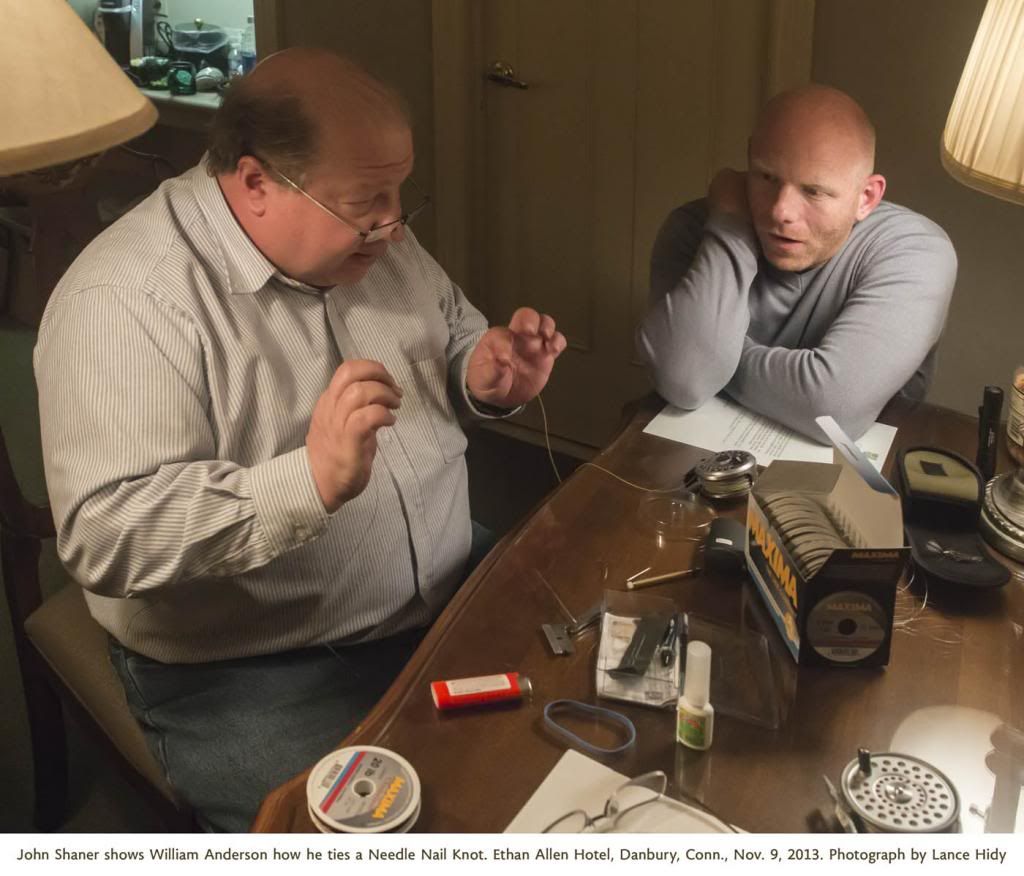Post
by William Anderson » Mon Nov 25, 2013 1:48 pm
Needle Nail Knot – John Shaner’s Technique for connecting line to leader
Required items: Single edge razor blade, appropriately sized sewing needle or bodkin, lighter, large diameter paperclip (nail, tube, or nail knot tool, to your preference). John uses the paperclip.
There are several different ways to tie the knot; most don't include heating the needle. This method does.
1. The razor blade is used: one, to cut an acute, clean angle in the butt end of the leader material (easier to thread the leader material into the fly line once the channel is created) and two, to make a nice, clean perpendicular cut to the fly line, removing the manufacturers welded loop.
2. Insert the needle into the end of the fly line (using a pin vise if necessary, a jeweler’s tool) working it up to about one-half inch inside. You might slightly heat the needle at this point to gain a little more depth as it resists going any further.
3. Bend the line to 90* so you can cleanly exit the needle partially leaving about an inch or so of the needle exposed from the entry point and about half an inch of the point protruding from the exit point. Be very careful to avoid injuries at this point.
4. Very lightly pass a flame (the lighter) under the needle, creating just enough heat to mold a channel and stabilize an exit hole in the fly line, making it possible to insert and pass the angled leader butt into and out of the fly line through the channel. The heat helps expand and set the line, preventing it from contracting, leaving an open channel for the leader butt.
5. Holding the paperclip parallel to the fly line, tie a nail knot, pull it snug, careful to align the wraps, wet the knot and bring it tight using your rear left molars. =) The paperclip serves the purpose of he nail or tube or nail knot tool. A large paper clip is a perfect diameter and cheap and easy to find.
6. Trim the tag end of the nylon leader butt.
“The Whitlock Super Glue splice is also a super smooth connection but you need glue which always seems to be dried up in the bottle. The Needle/ Nail Knot is a mechanical connection, and the "tools" are household items, so in a pinch you can improvise everything you need to to tie it. And believe me, I've done just that many times.
A simple Nail Knot is just as strong and less fussy to tie but is a little bulkier. I use it for heavier, 6 weight and up, lines. But for the way I fish, the Needle/Nail Knot is by far the best Line to Leader connection I've used and it has served me well for many years.” J.S.
“This really is an exceptional connection and very slick. It would seem a difficulty if you were going to change leaders often, but as his leaders are all hand tied using decreasing diameter leader material, connected with blood knots, the retying of the lower end of the leader is simple enough while streamside and should last a season or more without having to recreate the line/leader connection again for some time. Another benefit is the perfect transfer of energy from the line to the leader and creating a highly tailored loop/presentation condition. John carries two reels, one for his wet fly fishing set up and another for dries and small, unweighted nymphs, fished upstream on a greased leader. Each reel is set-up to balance the reel and rod for fly line type, reel weight, leader action and leader length, given it’s specialized function. The needle knot connection seems to me a superior connection in regards to accuracy and performance. Less convenient if you’re used to a loop-to-loop connection, but with practice it seems worthwhile, especially for those who go to great pains to finesse every other aspect of their approach. I would suspect he could rebuild a hand tied leader in waist deep water using ten sections of leader material, connected with blood knots quicker than I could reattach a fresh knotless, tapered leader with a loop-to-loop connection. Consider me a convert, very excited about adding something so fundamental to my approach.” W.A.
"A man should not try to eliminate his complexes, but rather come into accord with them. They are ultimately what directs his conduct in the world." Sigmund Freud.
www.WilliamsFavorite.com

